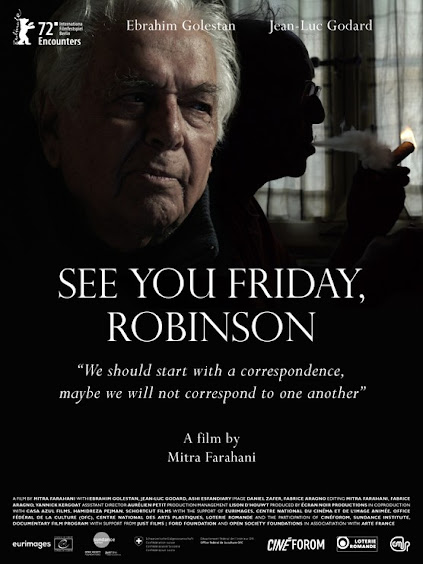 |
RIP Ebrahim Golestan (1922 – 2023)
A long-distance dialogue between Ebrahim Golestan, a giant of Iranian cinema and literature (now only a few months shy of his 100th birthday) and Swiss-French filmmaker Jean-Luc Godard forms the basis of this latest film by Mitra Farahani. Among the most gifted documentarians from Iran, Farahani mediates between two seemingly irreconcilable worlds to create a unique epistolary work. Its elegant, hybrid style takes us from encounters with shadows – the first time we see each of these artists – to the inner lives of flesh and blood individuals; vulnerable, pained, caring, endlessly searching.
More than seven years in the making, See You Friday, Robinson is a search for points of convergence – each artist now seen living on his chosen island of solitude but connected through internet technology. Godard, still largely preoccupied with ideas concerning image and language, plays the role of pitcher. Golestan, a man of expansion and clarity, aims to find meaning in the array of audio-visual puzzles he receives. Godard acts as if everything is known by everybody, to which Golestan replies that everybody is not born yet. Farahani brings the idea of "parallels" into the form of the film itself. She even adds her own, as when selected passages from the life of Beethoven are narrated, with the accompaniment of the composer's music, to complete her puzzle picture of creativity in the twilight of life.
Farahani mysteriously leaves out of the frame the key works made by these two artists, only showing excerpts from their films when one of the two is actually watching one. We see Golestan and his wife (also a central figure in the film) watching JLG/JLG – autoportrait de décembre, and Golestan's own Hills of Marlik also features. But there is an abundance of other citations – from Wittgenstein to Joyce; Tolstoy to Goya; Chekhov to Johnny Guitar; Puccini to Elias Canetti. Godard recites the closing lines of Dashiell Hammett's The Thin Man ("but it's all pretty unsatisfactory"), foregrounding a central theme of the film, while Golestan's deep admiration for the thirteenth-century Persian poet Saadi acts as the driving force.
Yet, beyond the printed word and the image, the film finds some of its answers in the ordinary rooms of these two men; in their calculated cycle of life, climbing and descending the stairs. Then there's the life-and-death parallel that Farahani tries to ward off through her preservation of every banal bit of life that she encounters and manages to translate into poetry. — Ehsan Khoshbakht

No comments:
Post a Comment